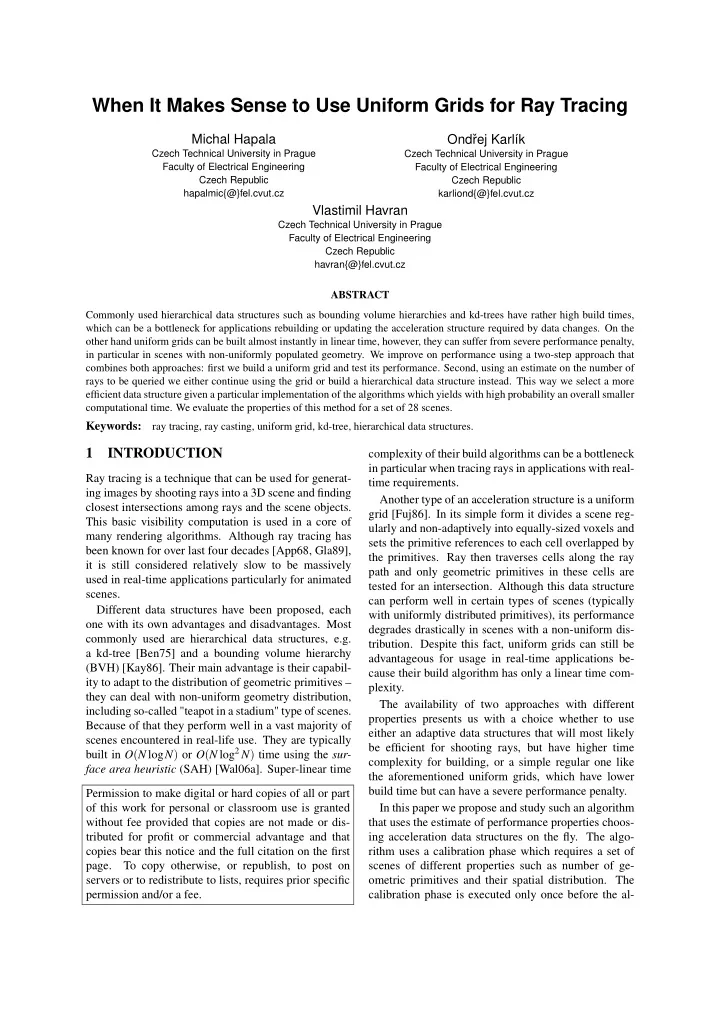

When It Makes Sense to Use Uniform Grids for Ray Tracing Michal Hapala Ondˇ rej Karlík Czech Technical University in Prague Czech Technical University in Prague Faculty of Electrical Engineering Faculty of Electrical Engineering Czech Republic Czech Republic hapalmic{@}fel.cvut.cz karliond{@}fel.cvut.cz Vlastimil Havran Czech Technical University in Prague Faculty of Electrical Engineering Czech Republic havran{@}fel.cvut.cz ABSTRACT Commonly used hierarchical data structures such as bounding volume hierarchies and kd-trees have rather high build times, which can be a bottleneck for applications rebuilding or updating the acceleration structure required by data changes. On the other hand uniform grids can be built almost instantly in linear time, however, they can suffer from severe performance penalty, in particular in scenes with non-uniformly populated geometry. We improve on performance using a two-step approach that combines both approaches: first we build a uniform grid and test its performance. Second, using an estimate on the number of rays to be queried we either continue using the grid or build a hierarchical data structure instead. This way we select a more efficient data structure given a particular implementation of the algorithms which yields with high probability an overall smaller computational time. We evaluate the properties of this method for a set of 28 scenes. Keywords: ray tracing, ray casting, uniform grid, kd-tree, hierarchical data structures. 1 INTRODUCTION complexity of their build algorithms can be a bottleneck in particular when tracing rays in applications with real- Ray tracing is a technique that can be used for generat- time requirements. ing images by shooting rays into a 3D scene and finding Another type of an acceleration structure is a uniform closest intersections among rays and the scene objects. grid [Fuj86]. In its simple form it divides a scene reg- This basic visibility computation is used in a core of ularly and non-adaptively into equally-sized voxels and many rendering algorithms. Although ray tracing has sets the primitive references to each cell overlapped by been known for over last four decades [App68, Gla89], the primitives. Ray then traverses cells along the ray it is still considered relatively slow to be massively path and only geometric primitives in these cells are used in real-time applications particularly for animated tested for an intersection. Although this data structure scenes. can perform well in certain types of scenes (typically Different data structures have been proposed, each with uniformly distributed primitives), its performance one with its own advantages and disadvantages. Most degrades drastically in scenes with a non-uniform dis- commonly used are hierarchical data structures, e.g. tribution. Despite this fact, uniform grids can still be a kd-tree [Ben75] and a bounding volume hierarchy advantageous for usage in real-time applications be- (BVH) [Kay86]. Their main advantage is their capabil- cause their build algorithm has only a linear time com- ity to adapt to the distribution of geometric primitives – plexity. they can deal with non-uniform geometry distribution, The availability of two approaches with different including so-called "teapot in a stadium" type of scenes. properties presents us with a choice whether to use Because of that they perform well in a vast majority of either an adaptive data structures that will most likely scenes encountered in real-life use. They are typically be efficient for shooting rays, but have higher time built in O ( N log N ) or O ( N log 2 N ) time using the sur- complexity for building, or a simple regular one like face area heuristic (SAH) [Wal06a]. Super-linear time the aforementioned uniform grids, which have lower build time but can have a severe performance penalty. Permission to make digital or hard copies of all or part of this work for personal or classroom use is granted In this paper we propose and study such an algorithm without fee provided that copies are not made or dis- that uses the estimate of performance properties choos- tributed for profit or commercial advantage and that ing acceleration data structures on the fly. The algo- copies bear this notice and the full citation on the first rithm uses a calibration phase which requires a set of page. To copy otherwise, or republish, to post on scenes of different properties such as number of ge- servers or to redistribute to lists, requires prior specific ometric primitives and their spatial distribution. The permission and/or a fee. calibration phase is executed only once before the al-
Recommend
More recommend